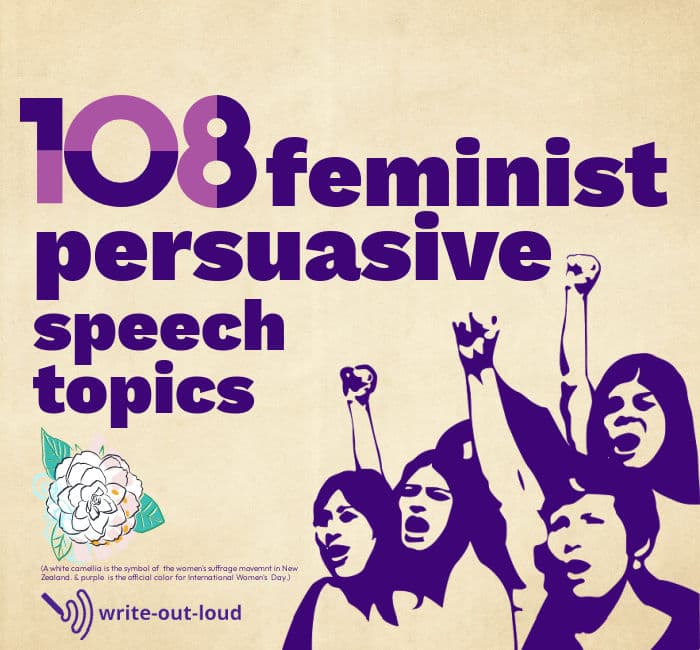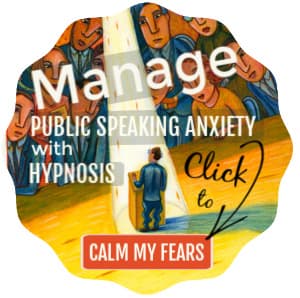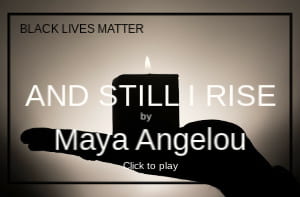- HOME ›
- Speech topics ›
- Feminist persuasive speech topics
108 feminist persuasive speech topics
- the top current women's rights & feminist issues
By: Susan Dugdale
There are 108 persuasive speech topics here covering many current feminist issues. For example:
- that copy-cat fast fashion reinforces the relentless consumer cycle and the poverty trap,
- that the advertising industry deliberately manufactures and supports body image insecurities to serve its own ends,
- that gendered language reinforces the patriarchal structure of society...
They're provocative and challenging topics raising issues that I like to think should be of concern to us all!
Use the quick links to find a topic you want to explore
- 25 feminist persuasive speech topics about beauty and fashion
- 16 the media and feminism topics
- 8 the role of language and feminism speech ideas
- 8 feminist speech ideas about culture and arts
- 9 topics on education and gendered expectations
- 27 feminist topics about society & social inequality
- 8 business & work related feminist speech topics
- Resources for preparing persuasive speeches
- References for feminism

What is 'feminism'?
Feminism is defined as belief in and advocacy of the political, economic, and social equality of the sexes, expressed especially through organized activity on behalf of women's rights and interests.
25 feminist speech topics about beauty & fashion
- that from puberty onward a woman is targeted by cosmetic companies
- that the shape of woman’s body is valued over its health
- that physical beauty in a woman is conferred by popular beliefs
- that striving for what is regarded as the epitome of female physical perfection destroys women
- that physical perfection is a myth
- that compassion and collaboration is needed between women (and men) rather than competition and comparison
- that beauty, fashion and feminism can co-exist
- that clothing reflects social position or class
- that the fashionable clothing of any era reflects its dominate cultural beliefs
- that a modern feminist does not need to ban either the bra or the razor
- that prescriptive beauty norms (PBNs) reinforce sexism, racism, colorism, classism, ableism, ageism, and gender norms
- that western feminine beauty standards dominate globally
- that there is no legitimate historical or biological justification for the ‘white’ beauty myth
- that modern beauty standards were used as “political weapons" against women’s advancement (see Naomi Wolfe - The Beauty Myth)
- that the beauty industry cynically and callously exploits women through “self-empowerment” campaigns – eg L'Oreal's “Because you're worth it”
- that beauty shaming of any sort is shameful
- that health and beauty need to work together for the empowerment of women
- that beauty and fashion role models need to be independent of major brands
- that fashion and cosmetic industries have a moral responsibility to use the immense power they have in shaping people’s lives for their betterment
- that the unfair balance of power between the consumers of fashionable clothing and those who make it is a feminist issue
- that copy-cat fast fashion reinforces the relentless consumer cycle and the poverty trap
- that genuinely sustainable fashion is only responsible way forward
- that clothing/fashion can make a feminist statement. For example: the 1850s “freedom” or “bloomer” dress named after women’s rights and temperance advocate Amelia Bloomer, the wearing of trousers, shorts, or mini skirts by women, or skirts and dresses by men
- that boss dressing for women is unnecessary and toxic
- that establishing superiority through wearing elitist fashion is an age old ploy
16 the media and feminism speech topics
- that feminism in mainstream media is often misrepresented through lack of understanding
- that some media deliberately encourages a narrow polarizing definition of feminism to whip up interest and drama for its own sake
- that mainstream media plays a significant role in keeping women marginalized
- that social media has created an independent level playing field for feminists globally
- that the #metoo movement reaffirmed the need for community and solidarity amongst feminists
- that the advertising industry deliberately manufactures and supports ongoing body image insecurities to serve its own ends
- that the advertising industry decides and deifies what physical perfection looks like
- that the ideal cover girl body/face is a myth
- that eating disorders and negative body image problems are increased by the unrealistic beauty standards set by mainstream media
- that women get media coverage for doing newsworthy things and being beautiful. Men get media coverage for doing newsworthy things.
- that social media gives traditionally private issues a platform for discussion and change: abortion, domestic abuse, pay equity
- that print media (broadsheets, magazines, newspapers...) have played and continue to play a vital role in feminist education
- that ‘the women’s hour’ and similar radio programs or podcasts have been and are an important part in highlighting feminist issues
- that ‘feminist wokeness’ has been hijacked by popular media
- that social media reinforces prejudices rather than challenges them because the smart use of analytics means we mainly see posts aligned with our viewpoints
- that social media has enabled and ‘normalized’ the spread of pornography: the use of bodies as a commodity to be traded
8 the role language and feminism speech ideas
- that frequently repeated platitudes (eg. girls will be girls and boys will be boys) are stereotypical straitjackets stifling change
- that the derogatory words for females and female genitalia frequently used to vent anger or frustration demonstrate the worth and value placed on women
- that feminism is neither male nor female
- that gendered language reinforces the patriarchal structure of society
- that sexist language needs to be called out and changed
- that gendered language limits women’s opportunities
- that gendered languages (French, Spanish, Arabic, Hindi...) need to become more inclusive
- that the real enemy of feminism is language
8 feminist speech ideas about culture and arts
- that limitations in any arena (work, sports, arts) placed on woman because they are women need challenging
- that male bias in the organizations awarding major awards and grants needs to change
- that the ideal woman in art is a figment of a male imagination
- that historically art has objectified women
- that heroic figures should be celebrated and honored for their deeds – not for what they look like or their gender
- that strong feisty female characters in literature can inspire change eg. Elizabeth Bennet from Jane Austen’s novel Pride and Prejudice, Jane Eyre from Charlotte Bronte’s novel of the same name, and Offred from Margaret Atwood’s The Hand Maiden’s Tale.
- that the role of feminist art in any field: literature, film, theatre, dance, sculpture..., is to transform and challenge stereotypes. Examples of feminist artists: Judy Chicago, Miriam Shapiro, Barbara Kruger (More: feminist art)
- that feminist musicians have used their influence as agents of change, and to inspire: Beyonce, Queen Latifah, Pussy Riot, Lorde, Aretha Franklin, Carole King, Nina Simone
9 topics on education and gendered expectations
- that there no subjects more suitable for boys than girls, or subjects more suitable for girls than boys
- that toys, clothing, and colors should be gender neutral
- that student achievement and behavioral expectations should be gender free
- that feminism should be actively modelled in the classroom
- that eligibility for educational institutions should be merit based
- that boys should not ‘punished’ or blamed for our patriarchal history
- that gendered performance is actively supported and encouraged by some educational philosophies and schools in order to maintain the status quo
- that the belief that ‘male’ and ‘female’ intelligence are different and that male intelligence is superior is false
- that education is vital for the advancement of black feminism
27 feminist topics about society & social inequality
- that rigidly adhered to gendered workplace and domestic roles sustain and support inequalities
- that domestic violence is typically a male gendered crime
- that patriarchal attitudes toward women make sexual harassment and rape inevitable
- that a safe legal abortion is a fundamental right for every person who wants one
- that humiliation and control either by fear and threat of rape, or rape itself, is an act toxic entitlement
- that a person is never ever ‘asking for it’: to be sexually harassed, or to be raped
- that safe methods of birth control should be freely available to whomever wants them
- that full sexual and reproductive health and rights for all people is an essential precondition to achieving gender equality
- that men should not have control over woman's sexual and reproductive decision-making
- that the increase in sperm donation is a feminist victory
- that a person can be a domestic goddess and a feminist
- that there is a positive difference between assertive and aggressive feminism
- that the shock tactics of feminist anarchists is justified
- that powerful feminist role models open the way for others to follow
- that intersectional feminism is essential to fully understand the deep ingrained inequalities of those experiencing overlapping forms of oppression
- that a feminist’s belief and practices are shaped by the country they live in, its dominant religious and cultural practices
- that female circumcision is an example of women’s oppression disguised as a cultural tradition
- that honor crimes are never justifiable
- that period poverty and stigma is a global feminist issue
- that we need to accept that some women want to remain protected by patriarchal practices and beliefs
- that environmental issues are feminist issues
- that everybody benefits from feminism
- that feminism works towards equality, not female superiority
- that anti-feminist myths (that feminists are angry women who blame men for their problems, that feminists are anti marriage, that feminists have no sense of humor, that feminists are not ‘natural’ mothers, that feminists are anti religion, that feminists are actually all lesbians ...) are desperate attempts to maintain the patriarchal status quo
- that toxic femininity is a by-product of fear and insecurity eg. The need to ridicule another woman in order to impress a man, shaming a man for not being ‘manly’, raging against a women for being seen to be powerful, competent and successful in a leadership position ...
- that blaming the patriarchy is far too simple
- that one can hold religious beliefs and be feminist
8 business & work related feminist speech topics
- that gendered jobs and job titles belong in the past
- that pay scales should be based on merit, not gender
- that adequate maternity and child care plus parental leave provisions should be mandatory
- that flexible working hours benefits both the business and its employees
- that token feminism is not enough
- that corporate feminism is for wealthy white women
- that feminism and capitalism are in conflict
- that women in power owe it to other women to work for their empowerment
Useful resources
The first three resources below provide an excellent starting point to get a broad overview of feminism: its history, development and current issues.
I've included the fourth link because I'm a New Zealander, and proud of what its women's suffrage movement achieved: the vote for women in 1893.
- What’s the definition of feminism? 12 TED talks that explain it to you
- An overview of feminist philosophy – Stanford University, USA
- Britannica: an excellent over of the history and development of feminism
- The symbolism of a white camellia and the Suffrage Movement in New Zealand
How to choose a good persuasive speech topic and preparing a great speech
For a more in-depth discussion about choosing a good persuasive topic, and crafting a persuasive speech please see:
- persuasive speech ideas and read all the notes under the heading “What make a speech topic good?"
- writing a persuasive speech. You’ll find notes covering:
- setting a speech goal,
- audience analysis,
- evidence and empathy (the need for proof or evidence to back what you’re saying as well as showing you understand, or empathize with, the positions of those for and against your proposal),
- balance and obstacles (to address points against your proposal, the obstacles, in a fair and balanced way),
- varying structural patterns (ways to organize you material) and more.
And click this link for hundreds more persuasive speech topic suggestions. ☺




